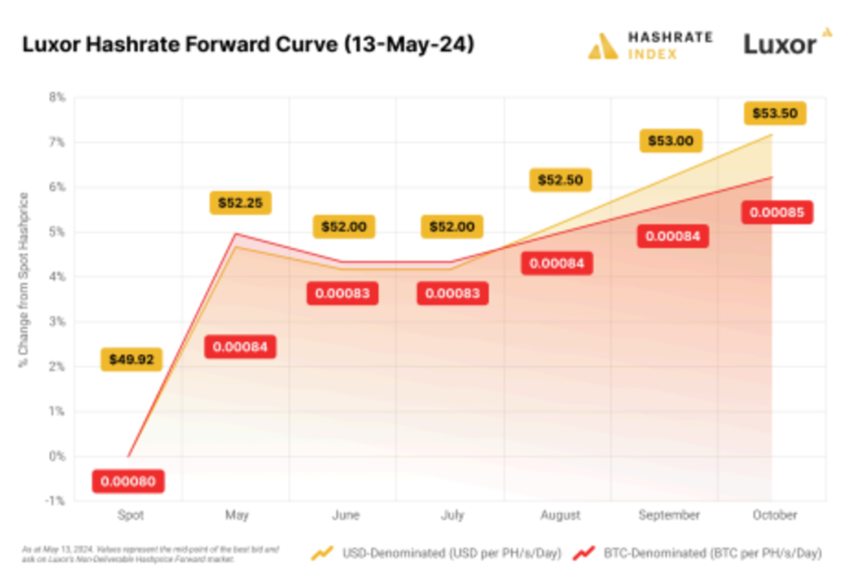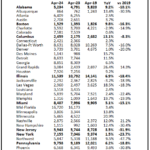introduction:
Luxor Technology’s latest Q1 2024 Hashrate Index report details how the Bitcoin mining sector is performing following the fourth Bitcoin halving. The report provides key insights into key metrics such as Bitcoin hashrate, hash price, hashrate forward, and Bitcoin mining stocks, highlighting the adaptability of the Bitcoin mining industry while also discussing the challenges miners face in a world of 3.125 BTC block subsidies.
Bitcoin hash price and hash rate fluctuate
With the fourth halving now behind us, Bitcoin miners are keeping a close eye on two metrics in particular: hash price and network hashrate.
The hash price is a measure of the revenue a miner can earn per day when hashing in a fully pay-per-share mining pool. All else being equal, the hash price is expected to halve due to the halving, when Bitcoin’s block subsidy is halved.
However, this did not happen immediately. Hash price experienced extreme volatility immediately before and after the halving. In the hour when the halving occurred, hash price dropped to $74/PH per day, but quickly rose to a peak of $183/PH per day due to a surge in transaction fees from Runes trading activity. The Runes hype did not last long, and hash price quickly plummeted to an all-time low of $44/PH before stabilizing at its current level of $50/PH. The previous all-time low for hash price, $55/PH, occurred in the aftermath of the FTX debacle in 2022. The new hash price reality highlights the brutal economic situation miners now face.
Which brings us to the next major metric the halving affected: hashrate. In Q1 2024, Bitcoin’s 7-day average hashrate increased by 19% to 611 EH/s, and then increased another 6% in April to reach an all-time high of 650 EH/s. Now that the post-halving dust has settled, Bitcoin’s hashrate is down 10% from its all-time high to 580 EH/s.
Bitcoin’s hashrate is expected to experience only modest growth this year as mining margins are compressed and with summer approaching, power consumption cuts from industrial-scale mining farms in Texas and elsewhere will likely be required, creating a headwind for hashrate growth.
Hashprice is trading in contango
Notably, traders in the hashrate market believe that hash prices have bottomed out, at least for now.
Luxor’s hashrate forward, a Bitcoin mining derivative that allows miners and other participants to buy and sell hashrate at a fixed price at a future date, is trading in contango. This means that hashrate traders expect the hash price to be higher than the current spot price in the coming months. This suggests that there is bullish sentiment among hashrate forward traders, who expect that rising transaction fees and/or falling mining difficulty could drive up the hash price.

As mentioned in the previous section, cutbacks in mining hotspots like Texas could temporarily take hashrate offline, improving hash prices and mining margins.
The ASIC market is in the process of price discovery
The ASIC market experienced a significant slowdown as the halving approached, with various models seeing notable price declines despite an increase in the average hash price in Q1 2024. Not surprisingly, this increased the price premium of the Antminer S21 compared to other models, signaling a strategic shift among Bitcoin miners to more efficient hardware to mitigate the decline in post-halving revenues.

Bitcoin mining stocks enter arms race over hash rate and efficiency
All major public Bitcoin miners have increased their hashrate throughout 2023, with some miners taking even more aggressive steps to boost their hashrate in early 2024. With the block subsidy halving, it is imperative that miners equip their ASIC fleets with modern hardware to stay competitive in the hashrate arms race and lower their operational costs per unit of hashrate.

Predictions and outlook for 2024 and beyond
Unless the price of Bitcoin rises significantly or transaction fees soar, 2024 will be a tough year for Bitcoin miners. Now more than ever, transaction fees will play a significant role in miners’ revenues.
In terms of adapting to the new normal, companies that did not do so in 2023 will need to get creative with their operational strategies. Not only can they optimize their fleet’s power efficiency with the latest ASIC models and secure more favorable power contracts, but they can also optimize their ASICs with aftermarket firmware, adopt more sophisticated hedging strategies, and look for alternative revenue streams and places to reduce operational costs.
In the US and Canadian context, we expect to see increased consolidation through mergers and acquisitions as companies take advantage of bargain sale prices for ASICs and mining facilities. As the mining sector continues to mature, mining will become more entrenched and integrated into the energy system, and we believe the current halving will accelerate this consolidation as miners turn to power producing sources to take advantage of the lowest possible electricity costs.
This is a guest post by Alessandro Cecere and Colin Harper. The opinions expressed are entirely their own and do not necessarily reflect the opinions of BTC Inc or Bitcoin Magazine.







